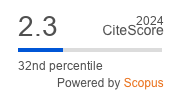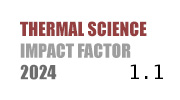ABSTRACT
The NO formation characteristics in laminar NH3-CH4 premixed flat flames and their relationship with chemiluminescence are numerically investigated across different ammonia blending ratios (XNH3, 0-1.0) and equivalence ratios (φ, 0.7-1.3). The applicability of the reaction mechanism and flame model in predicting the formation of NO and OH*/NH*/CH*/CO2*/NH2* radicals is verified. The results show that the peak flame temperature gradually increases with increasing XNH3, while it first increases and then decreases with increasing φ. For NO mole fraction, increasing XNH3 affects the competition among reactions R763 (HNO + H = NO + H2), R765 (HNO + OH = NO + H2O), and R842 (NH + NO = N2O + H) by altering the HNO and NH mole fractions, causing NO to first increase and then decrease. Moreover, increasing φ continuously reduces the formation rate of NO via R765. For OH*/NH*/CH*/CO2*/NH2* mole fractions, as XNH3 increases, NH* and CH* peak at XNH3 = 0.3 and 0.6, respectively; OH* and NH2* increase monotonically, while CO2* decreases. With increasing φ, the peaks of OH*/NH*/CH*/CO2* appear at φ = 1.0/1.0/1.0/0.8, while NH2* continues to rise. Regarding the relationship between NO and chemiluminescence, a nearly monotonic relationship is observed between the peak mole fraction of NO and CO2*. With varying XNH3, similar relationships exist between NO and the ratios of CO2*/OH*, CO2*/NH*, and CO2*/CH*, but these relationships break down at high XNH3. Over a wide φ range, the NH2*/CO2* ratio shows good potential for predicting NO formation and emission. This study facilitates accurate monitoring and emission control of NOx in NH3-blended combustion systems.
KEYWORDS
PAPER SUBMITTED: 2025-05-16
PAPER REVISED: 2025-08-08
PAPER ACCEPTED: 2025-08-14
PUBLISHED ONLINE: 2025-09-13
- Pitsch, H., The transition to sustainable combustion: Hydrogen- and carbon-based future fuels and methods for dealing with their challenges, Proceedings of the Combustion Institute, 40 (2024), 1, pp. 105638. doi.org/10.1016/j.proci.2024.105638
- Zhang, M., et al., Flame stabilization and emission characteristics of ammonia combustion in lab-scale gas turbine combustors: Recent progress and prospects, Progress in Energy and Combustion Science, 106 (2025), pp. 101193. doi.org/10.1016/j.pecs.2024.101193
- Valera-Medina, A., et al., Ammonia for power, Progress in Energy and Combustion Science, 69 (2018), pp. 63-102. doi.org/10.1016/j.pecs.2018.07.001
- Dimitriou, P., R. Javaid, A review of ammonia as a compression ignition engine fuel, International Journal of Hydrogen Energy, 45 (2020), 11, pp. 7098-7118. doi.org/10.1016/j.ijhydene.2019.12.209
- Cheng, Q., et al., Ammonia as a sustainable fuel: Review and novel strategies, Renewable and Sustainable Energy Reviews, 207 (2025), pp. 114995. doi.org/10.1016/j.rser.2024.114995
- Kobayashi, H., et al., Science and technology of ammonia combustion, Proceedings of the Combustion Institute, 37 (2019), 1, pp. 109-133. doi.org/10.1016/j.proci.2018.09.029
- Kumar, L., A.K. Sleiti, Systematic review on ammonia as a sustainable fuel for combustion, Renewable and Sustainable Energy Reviews, 202 (2024), pp. 114699. doi.org/10.1016/j.rser.2024.114699
- Reiter, A.J., S.-C. Kong, Combustion and emissions characteristics of compression-ignition engine using dual ammonia-diesel fuel, Fuel, 90 (2011), 1, pp. 87-97. doi.org/10.1016/j.fuel.2010.07.055
- Ariemma, G.B., et al., Ammonia/Methane combustion: Stability and NOx emissions, Combustion and Flame, 241 (2022), pp. 112071. doi.org/10.1016/j.combustflame.2022.112071
- Elbaz, A.M., et al., Stability and characteristics of NH3/CH4/air flames in a combustor fired by a double swirl stabilized burner, Proceedings of the Combustion Institute, 39 (2023), 4, pp. 4205-4213. doi.org/10.1016/j.proci.2022.06.004
- Okafor, E.C., et al., Control of NOx and other emissions in micro gas turbine combustors fuelled with mixtures of methane and ammonia, Combustion and Flame, 211 (2020), pp. 406-416. doi.org/10.1016/j.combustflame.2019.10.012
- Li, R., et al., Chemical mechanism development and reduction for combustion of NH3/H2/CH4 mixtures, Fuel, 257 (2019), pp. 116059. doi.org/10.1016/j.fuel.2019.116059
- Ahmed, M.M.A., et al., Flame stabilization and pollutant emissions of turbulent ammonia and blended ammonia flames: A review of the recent experimental and numerical advances, Fuel Communications, 20 (2024), pp. 100127. doi.org/10.1016/j.jfueco.2024.100127
- Somarathne, K.D.K.A., et al., Emission characteristics of turbulent non-premixed ammonia/air and methane/air swirl flames through a rich-lean combustor under various wall thermal boundary conditions at high pressure, Combustion and Flame, 210 (2019), pp. 247-261. doi.org/10.1016/j.combustflame.2019.08.037
- Udaybhanu, G., et al., Experimental and numerical investigation of NH3 flames under the influence of hot flue gases in a novel two stage porous burner, Fuel, 396 (2025), pp. 135395. doi.org/10.1016/j.fuel.2025.135395
- Okafor, E.C., et al., Experimental and numerical study of the laminar burning velocity of CH4-NH3-air premixed flames, Combustion and Flame, 187 (2018), pp. 185-198. doi.org/10.1016/j.combustflame.2017.09.002
- Glarborg, P., et al., Modeling nitrogen chemistry in combustion, Progress in Energy and Combustion Science, 67 (2018), pp. 31-68. doi.org/10.1016/j.pecs.2018.01.002
- Wang, S., et al., Applying heat flux method to laminar burning velocity measurements of NH3/CH4/air at elevated pressures and kinetic modeling study, Combustion and Flame, 236 (2022), pp. 111788. doi.org/10.1016/j.combustflame.2021.111788
- Zhu, X., et al., NO and OH* emission characteristics of very-lean to stoichiometric ammonia-hydrogen-air swirl flames, Proceedings of the Combustion Institute, 38 (2021), 4, pp. 5155-5162. doi.org/10.1016/j.proci.2020.06.275
- Li, Z., et al., Revealing the competitive relationship between soot formation and chemiluminescence, Combustion and Flame, 245 (2022), pp. 112335. doi.org/10.1016/j.combustflame.2022.112335
- Li, Z., et al., Investigation of soot inception limits and chemiluminescence characteristics of laminar coflow diffusion flames in C/O ratio space, Fuel, 327 (2022), pp. 125140. doi.org/10.1016/j.fuel.2022.125140
- Li, Z., et al., Experimental investigation of the competitive relationship between soot formation and chemiluminescence in laminar ammonia-ethylene inverse diffusion flames, Proceedings of the Combustion Institute, 40 (2024), 1, pp. 105232. doi.org/10.1016/j.proci.2024.105232
- Capriolo, G., et al., An experimental and kinetic study of OH(A2Σ+) formation and quenching in ammonia-hydrogen-air flames, Combustion and Flame, 260 (2024), pp. 113258. doi.org/10.1016/j.combustflame.2023.113258
- Ballester, J., T. García-Armingol, Diagnostic techniques for the monitoring and control of practical flames, Progress in Energy and Combustion Science, 36 (2010), 4, pp. 375-411. doi.org/10.1016/j.pecs.2009.11.005
- Hossain, A., Y. Nakamura, A numerical study on the ability to predict the heat release rate using CH* chemiluminescence in non-sooting counterflow diffusion flames, Combustion and Flame, 161 (2014), 1, pp. 162-172. doi.org/10.1016/j.combustflame.2013.08.021
- Yan, S., et al., Investigation of the correlation between OH*, CH* chemiluminescence and heat release rate in methane inverse diffusion flame, Energy, 283 (2023), pp. 129162. doi.org/10.1016/j.energy.2023.129162
- Mashruk, S., et al., Chemiluminescent footprint of premixed ammonia-methane-air swirling flames, Proceedings of the Combustion Institute, 39 (2023), 1, pp. 1415-1423. doi.org/10.1016/j.proci.2022.08.073
- Pugh, D., et al., An investigation of ammonia primary flame combustor concepts for emissions reduction with OH*, NH2* and NH* chemiluminescence at elevated conditions, Proceedings of the Combustion Institute, 38 (2021), 4, pp. 6451-6459. doi.org/10.1016/j.proci.2020.06.310
- Zhu, X., et al., Chemiluminescence signature of premixed ammonia-methane-air flames, Combustion and Flame, 231 (2021), pp. 111508. doi.org/10.1016/j.combustflame.2021.111508
- Guiberti, T.F., et al., Chemiluminescence- and machine learning-based monitoring of premixed ammonia-methane-air flames, Applications in Energy and Combustion Science, 16 (2023), pp. 100212. doi.org/10.1016/j.jaecs.2023.100212
- Liu, J., et al., Experimental and modeling study on the ignition delay times of ammonia/methane mixtures at high dilution and high temperatures, Proceedings of the Combustion Institute, 39 (2023), 4, pp. 4399-4407. doi.org/10.1016/j.proci.2022.07.265
- Konnov, A.A., An exploratory modelling study of chemiluminescence in ammonia-fuelled flames. Part 1, Combustion and Flame, 253 (2023), pp. 112788. doi.org/10.1016/j.combustflame.2023.112788
- Konnov, A.A., An exploratory modelling study of chemiluminescence in ammonia-fuelled flames. Part 2, Combustion and Flame, 253 (2023), pp. 112789. doi.org/10.1016/j.combustflame.2023.112789
- Issayev, G., et al., Spatially resolved NH* and OH* profiles in ammonia-hydrogen-air counterflow diffusion flames, Proceedings of the Combustion Institute, 40 (2024), 1, pp. 105427. doi.org/10.1016/j.proci.2024.105427
- Li, Q., et al., A comprehensive parametric study on NO and N2O formation in ammonia-methane cofired premixed flames: Spatially resolved measurements and kinetic analysis, Combustion and Flame, 272 (2025), pp. 113851. doi.org/10.1016/j.combustflame.2024.113851
- Konnov, A.A., Implementation of the NCN pathway of prompt-NO formation in the detailed reaction mechanism, Combustion and Flame, 156 (2009), 11, pp. 2093-2105. doi.org/10.1016/j.combustflame.2009.03.016

